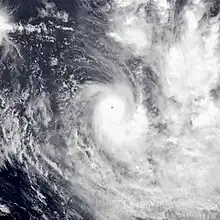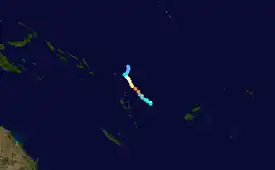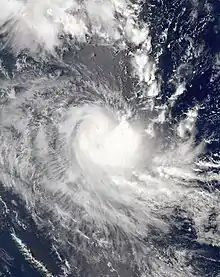 Severe Tropical Cyclone Xavier at its peak intensity. | |
| Meteorological history | |
|---|---|
| Formed | October 20, 2006 |
| Dissipated | October 26, 2006 |
| Category 4 severe tropical cyclone | |
| 10-minute sustained (FMS) | |
| Highest winds | 175 km/h (110 mph) |
| Lowest pressure | 930 hPa (mbar); 27.46 inHg |
| Category 4-equivalent tropical cyclone | |
| 1-minute sustained (SSHWS/JTWC) | |
| Highest winds | 215 km/h (130 mph) |
| Lowest pressure | 927 hPa (mbar); 27.37 inHg |
| Overall effects | |
| Fatalities | None reported |
| Damage | Minimal |
| Areas affected | Vanuatu, Solomon Islands |
| IBTrACS | |
Part of the 2006–07 South Pacific cyclone season | |
Severe Tropical Cyclone Xavier was a strong pre-season cyclone that formed on October 20, 2006 to the north of the Santa Cruz Islands. Cyclone Xavier was also the strongest storm of the season. During the next day it rapidly developed and was designated as Tropical Depression 01F later that day, before being designated as Tropical Cyclone Xavier while over Santa Cruz early on October 22. Later on October 22, Xavier intensified into a category 3 severe tropical cyclone on the Australian Tropical Cyclone Intensity Scale, before passing over Tikopia early the next day. Xavier then reached its peak wind speeds of 175 km/h (110 mph 10-min), which made it a Category 4 cyclone early on October 24. Xavier stayed at its peak wind speeds until early the next day when it started to rapidly weaken, becoming a depression early on October 26. The remnants of Xavier persisted until October 28 before dissipating. There were no casualties reported as a result of the storm and little impact reported in the Solomon Islands and Vanuatu.
Meteorological history

Tropical storm (39–73 mph, 63–118 km/h)
Category 1 (74–95 mph, 119–153 km/h)
Category 2 (96–110 mph, 154–177 km/h)
Category 3 (111–129 mph, 178–208 km/h)
Category 4 (130–156 mph, 209–251 km/h)
Category 5 (≥157 mph, ≥252 km/h)
Unknown
During October 20, 2006 the Fiji Meteorological Service and the United States Joint Typhoon Warning Center started to monitor a tropical depression, that had developed within the South Pacific Convergence Zone to the north of Temotu Province in the Solomon Islands.[1][2][3] The system was located within an area of low to moderate vertical wind shear and had a good outflow in its northern and eastern quadrants.[4][5] Over the next day conditions surrounding the system rapidly became favourable for further development, with convection starting to wrap into a well defined low level circulation centre.[1][6] As a result, the depression rapidly developed further and was named Xavier by the FMS during October 22, after it had become a category 1 tropical cyclone on the Australian tropical cyclone intensity scale.[1][2] After the system was named the JTWC initiated advisories on the system and designated it as Tropical Cyclone 01P, while it was located over the Santa Cruz Islands.[1][7] Throughout October 22, Xavier's rapid intensification continued with it developing an eye feature and becoming a category 3 severe tropical cyclone.[1][2] During that day the system performed a small cyclonic loop over Temotu Province and passed near or over the Santa Cruz Island of Tikopia.[1][8]
The systems rapid intensification subsequently slowed down during October 23, as an upper-level anticyclone located to the northwest of the system impeded the systems outflow.[9] The system also started to move south-eastwards during that day, as a trough of low pressure created a break in the ridge of high pressure that was steering Xavier.[10] The FMS subsequently estimated during October 24, that the system had peaked as a Category 4 Severe Tropical Cyclone with 10-minute sustained wind speeds of 175 km/h (110 mph), while it was located about 220 km (135 mi) to the east of Vanua Lava in northern Vanuatu.[1][2] The JTWC also estimated during October 24, that the system had peaked with 1-minute sustained wind speeds of 215 km/h (135 mph), which made it equivalent to a category 4 hurricane on the Saffir-Simpson hurricane wind scale.[3] Over the next day the system maintained its peak intensity as it moved south-eastwards, before it turned westwards during the next day towards Vanuatu and rapidly weakened after it moved into an area of cooler sea-surface temperatures and strong vertical wind-shear.[1][2][8] As a result, during October 26, The FMS and JTWC both reported that the system had weakened into a tropical depression, with the JTWC issuing their final advisory on the system as they expected it to dissipate within 12 hours.[1][11] Xavier's remnants were last noted by the FMS during October 28, after the systems low level circulation centre was not able to be distinguished.[1]
Preparations and impact

Early on October 22, both RSMC Nadi and TCWC Brisbane started to issue special advisories to support the meteorological services of Vanuatu and the Solomon Islands in tracking the cyclone. As Xavier was over the islands of Santa Cruz the whole of Temotu Province was placed under a tropical cyclone gale warning, while cyclone watches were declared for Rennel, Bellona, and Vanuatu.[12] During the next 24 hours, the Torres and Banks Islands, as well as Espirito Santo, Maewo, Ambae, were placed under a cyclone warning.[13] The warnings for the Solomon Islands were then cancelled early the next day, while the warnings for Vanuatu were maintained until late on October 25, when RSMC Nadi discontinued them.[14][15]
There were no casualties as a result of Xavier.[16] In the Solomon Islands, communications to the Temotu province were lost.[17] When communications were restored on October 24, it was reported that there was only minor tree damage on the islands of Utupua and Vanikolo.[8] On Tikopia, crops sustained damage, though the effects were considered light given the circumstances.[8][16][18] Strong and gusty winds, rough seas and moderate to heavy swells were reported within the eastern Vanuatuan islands, however, no significant damage was reported within the islands.[1][8]
See also
References
- 1 2 3 4 5 6 7 8 9 10 11 RSMC Nadi — Tropical Cyclone Centre (December 8, 2008). Tropical Cyclone Seasonal Summary 2006–07 (Report). Fiji Meteorological Service. Archived from the original on March 4, 2016. Retrieved August 30, 2015.
- 1 2 3 4 5 RSMC Nadi — Tropical Cyclone Centre (May 22, 2009). "RSMC Nadi — Tropical Cyclone Centre Best Track Data for 2006/07 Cyclone Season". International Best Track Archive for Climate Stewardship. Fiji Meteorological Service. Retrieved August 30, 2015.
- 1 2 "Archived copy". Archived from the original on 2010-03-04. Retrieved 2009-12-31.
{{cite web}}: CS1 maint: archived copy as title (link) - ↑ "Tropical Disturbance Summary October 20, 2006 21z". MT Archive. Fiji Meteorological Service. October 20, 2006. Retrieved August 30, 2015.
- ↑ "Tropical Disturbance Summary October 21, 2006 06z". MT Archive. Fiji Meteorological Service. October 21, 2006. Retrieved August 30, 2015.
- ↑ "Tropical Cyclone Formation Alert October 21, 2006 21z". Australian Severe Weather. Joint Typhoon Warning Center. October 21, 2006. Archived from the original on March 3, 2016. Retrieved August 30, 2015.
- ↑ "Tropical Cyclone Warning 1 October 22, 2006 03z". Australian Severe Weather. Joint Typhoon Warning Center. October 22, 2006. Archived from the original on March 3, 2016. Retrieved August 30, 2015.
- 1 2 3 4 5 Padgett, Gary (February 6, 2007). "Monthly Global Tropical Cyclone Summary: October 2006". Australian Severe Weather. Archived from the original on September 23, 2015. Retrieved August 30, 2015.
- ↑ "Tropical Cyclone Warning 4 October 23, 2006 15z". Australian Severe Weather. Joint Typhoon Warning Center. October 23, 2006. Archived from the original on March 3, 2016. Retrieved August 30, 2015.
- ↑ "Tropical Cyclone Warning 3 October 23, 2006 03z". Australian Severe Weather. Joint Typhoon Warning Center. October 23, 2006. Archived from the original on March 3, 2016. Retrieved August 30, 2015.
- ↑ "Tropical Cyclone Warning 9 October 26, 2006 03z". Australian Severe Weather. Joint Typhoon Warning Center. October 26, 2006. Archived from the original on March 3, 2016. Retrieved August 30, 2015.
- ↑ Kevin Vang (2006-10-22). "Cyclone Xavier forms over the Eastern Solomon Islands". Asia-Pacific Disaster Alerts. Archived from the original on 2014-03-28. Retrieved 2009-06-06.
- ↑ Kevin Vang (2006-10-23). "Cyclone Xavier threatens Vanuatu". Asia-Pacific Disaster Alerts. Archived from the original on 2008-05-17. Retrieved 2009-06-06.
- ↑ Kevin Vang (2006-10-24). "Cyclone Xavier Strengthens East of Banks Islands". Asia-Pacific Disaster Alerts. Archived from the original on 2008-05-17. Retrieved 2009-06-06.
- ↑ Kevin Vang (2006-10-26). "Cyclone Xavier Weakens East of Vanuatu". Asia-Pacific Disaster Alerts. Archived from the original on 2008-05-17. Retrieved 2009-06-06.
- 1 2 "RSMC Nadi Season Summaries 2006, 2007, 2008" (PDF). Fiji Meteorological Service. World Meteorological Organization. 2008-12-08. Archived from the original (PDF) on 2009-03-18. Retrieved 2009-06-05.
- ↑ "Cyclone in Solomons and Vanuatu waters intensifies". Radio New Zealand International. 2006-10-23. Archived from the original on 2012-05-27. Retrieved 2009-06-28.
- ↑ "Extensive damage in southern Solomon's now northern Vanuatu being bashed by Xavier". People First Network. Radio New Zealand. 2006-10-24. Archived from the original on 2012-05-27. Retrieved 2009-06-28.
External links
- World Meteorological Organization
- Australian Bureau of Meteorology
- Fiji Meteorological Service
- New Zealand MetService
- Joint Typhoon Warning Center
